COVID-19 Spotlight: Tracking Community Outbreaks with Autosamplers
(Updated November 2021)
By now, we are well aware that viral transmission of COVID-19 takes place through respiratory routes. However, it's important to note the virus may exist in other parts of the body outside of the respiratory system, such as in the digestive tract. As scientists have continued to study the pandemic, they have tested various bodily substances and found novel coronavirus in human feces.
With this finding, we now know that wastewater sampling can detect the virus that causes COVID-19. By collecting these samples, concerned groups such as university researchers or state and federal governments can model the coronavirus's spread in near real-time, which will allow for ample reaction time to quell any further spread.
Many companies in the world offer testing services of wastewater samples specifically for the virus, so let’s discuss where, why, when, and how these samples are collected and preserved – and how we can also help make your COVID sample collection easier.
Where Are Scientists Collecting COVID-19 Virus Samples?
There are two primary types of studies underway to detect coronavirus in wastewater – detection within wastewater treatment facilities and further upstream at large residential buildings, like apartment complexes.
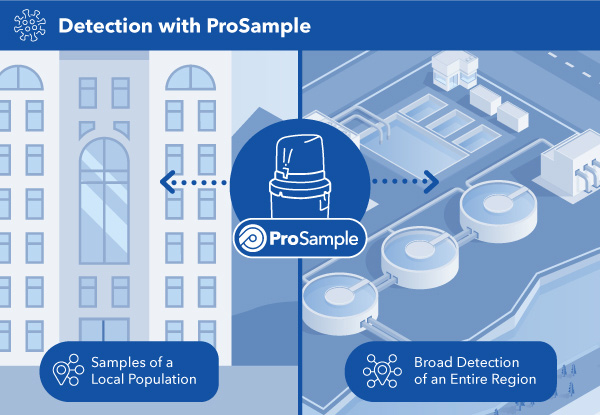
Health officials can take two different approaches to sampling for COVID RNA. They can collect water samples from a specific residential building—or from a wastewater treatment facility.
In the first scenario, treatment facilities collect wastewater from surrounding areas and process the materials for eventual disposition into rivers or solid waste facilities. For these facilities, identifying trends in the virus concentration amongst an entire community will help government officials determine the measures necessary to minimize further spread of the virus (e.g., the closure of businesses or limits on social gatherings). Testing has also been conducted at water treatment facilities to determine if drinking water can become contaminated with the COVID-19 virus. Thankfully, the answer at this point is no due to the treatment methods employed at these facilities, such as filtration and disinfection[1].
In the second scenario, researchers collect samples directly from the wastewater pipes of individual residential facilities, such as dormitories, retirement or nursing homes, prisons, and more. Samples collected from these facilities can pinpoint if a single person in the building may be infected, which could help officials isolate specific viral hotspots, rather than an entire community. For example, suppose samples collected outside of a dormitory indicated that a student resident tested positive for the COVID-19. In that case, the building could be quarantined to suppress the spread of infection to an entire college campus.
What are the Challenges of Collecting these Samples?
Several challenges accompany any water sampling effort, but let's focus on three in particular that are highly relevant in a post-COVID-19 world. The first challenge is location, the second is preservation, and the third is sample integrity and security.
As mentioned above, there are two typical sampling scenarios in the COVID research arena thus far, and the location of sample collection can be challenging to access in both. In a wastewater facility, it's critical to collect samples in the raw water before primary treatment. The EPA lists six different locations where wastewater sampling for influent samples can be conducted, depending on the equipment at the facility. These include the upflow siphon, upflow distribution box, aerated grit chamber, flume throat, pump wet-well, or downstream of the preliminary screening. Typically, it is encouraged to collect samples from a very turbulent environment to ensure that the sample is well-mixed.
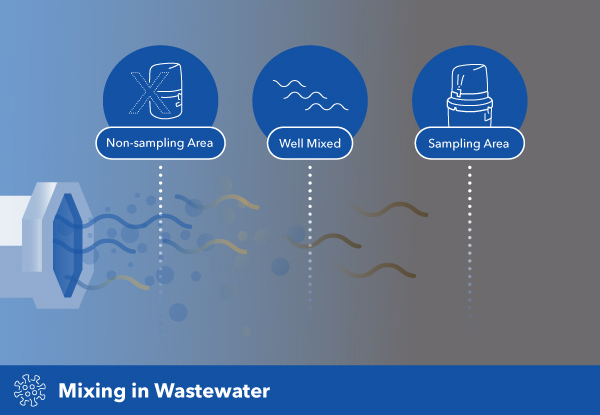
It’s critical to collect a representative water sample to ensure your COVID RNA analysis is as accurate as possible. It’s encouraged to collect samples from a turbulent environment to ensure the sample is well-mixed.
In the case of COVID-19 virus research, it is essential to note that while the probability is slim for the transmission of the virus from wastewater to scientist, airborne transmission is indeed possible if droplets of water or aerosols are suspended in the air that contains the virus[2]. Due to this safety concern, while sampling for airborne viruses in water, consideration should be made to where the sample collection occurs.
Similarly, in the second scenario, where wastewater samples are collected outside of highly populated facilities, entering manholes or infiltrating pipes is necessary. Here, there is the potential for direct exposure to concentrated waste when collecting water samples, and again, the possibility of contracting the virus is slim but still possible. Suppose the sample collection needs to occur in a location where the virus could be suspended in the air. In that case, the scientists or technicians collecting the sample should wear proper personal protection equipment (PPE) to best ensure their safety.

However, to mitigate some of the threat of these airborne droplets affecting our teams, we can incorporate automatic samplers, such as the ProSample, into our sampling regime. These samplers allow for a one-time exposure to the possibility of virus contraction during the initial instrument setup. But afterward, exposure is minimized due to proper barriers installed between the sampler and sample source. For example, you can install an automatic sampler above a manhole or next to a pipe access point, and the sample tubing would feed directly into the raw water. In this case, barriers such as manhole covers or walls protect the scientist. At wastewater facilities, operators can position samplers underneath or adjacent to the preliminary treatment location. The YSI ProSample is portable, so as the hotspots move throughout a region, so can the sampler.
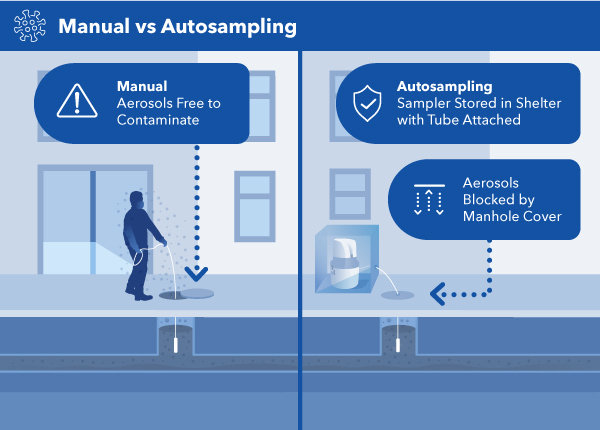
Manual water sampling can introduce many safety hazards for technicians. Autosamplers prevent direct contact with potentially dangerous sampling environments and reduce the risk of infection while sampling.
The second challenge of collecting water samples for COVID-19 testing is the preservation of the sample itself. Many environmental samples require preservation of the sample before it is analyzed to hold the sample in its current state. Examples of preservation methods include acidifying samples to be processed for nitrate+nitrite with sulfuric acid, acidifying samples for lead with nitric acid, or simply using ice to cool samples to be assessed for fecal coliform content.
But what preservation technique should scientists use with SARS-CoV-2 samples? Like with bacteria, virus samples are best preserved when held at 4°C or lower. Studies have shown that SARS-CoV-2 is stable for at least fourteen days if kept at these cool temperatures[4,5]. When collecting these samples manually, it is essential to remember to immediately put the sample on ice or in a refrigerator after collection.
Alternatively, an autosampler like the ProSample makes things much more manageable. With this instrument, you can fill the sampling chamber with ice to ensure that all samples collected are held at the proper temperature for preservation until someone can obtain them. The ProSample has a double-walled and insulated chamber that allows for longer ice retention, allowing a user some flexibility in scheduling their sample pick-up timing. Since most COVID samples will require a quick turnaround within 24 hours for processing, the sampler housing with ice is perfect for keeping these critical samples cool.
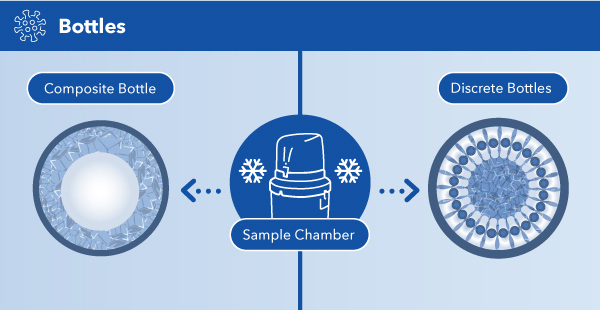
It is critical to preserve water samples at the proper temperature to maintain data integrity. An autosampler can be packed with ice to maintain a cool environment inside the instrument, regardless of whether you collect discrete or composite samples.
The final challenge that every sample program must consider is sample integrity, which goes hand-in-hand with sampler security. While most scientists will never have to consider the possibility of vandalism, when a sampler is being deployed near residential facilities or in high population areas, this is a very valid consideration. It costs a substantial amount of money to deploy a sampler correctly, send individuals out to collect the samples, and process the samples in the lab. The last thing anyone wants is for samples to be discarded due to contamination or improper preservation.
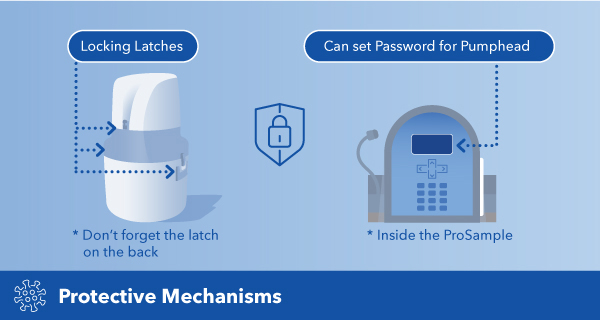
The ProSample provides many protective measures to protect the instrument (and water samples) from vandalism.
The ProSample can help you keep your samples safe and sound using a variety of mechanisms. Not only is the sample chamber able to be locked with locking latches, but the lid above the pump head can also be locked, ensuring that the sample and program are safe. Operators can even password-protect the instrument's user interface to avoid vandals from poking around and changing the device setup.
For added security, our Integrated Systems and Services group also offers a wide variety of housing options to protect your sampler, from fiberglass to metal materials. Using a housing will allow for the addition of other measurement devices and data loggers so that any continuous data that needs to be collected can be stored and transmitted via cellular or satellite telemetry. As a final note, the ProSample is also a compact and portable size when compared to other autosamplers on the market. It can be hidden relatively easily and can also fit into small places – like inside manholes when suspended with a harness.
How Else Can the ProSample be Useful for COVID-19 Sampling?
One of the pitfalls of manual sampling is that the collection timing is not always the same for each sample. With manual sampling, it isn't easy to collect samples at the same time interval. Your technician may not arrive on time (rush hour is the worst); it takes time to prepare to take a sample and equipment calibration time; you may need samples outside of regular working hours, etc. While modeling techniques may account for the time difference, if a scientist wants to ensure their samples are collected consistently, an autosampler is a fantastic solution.
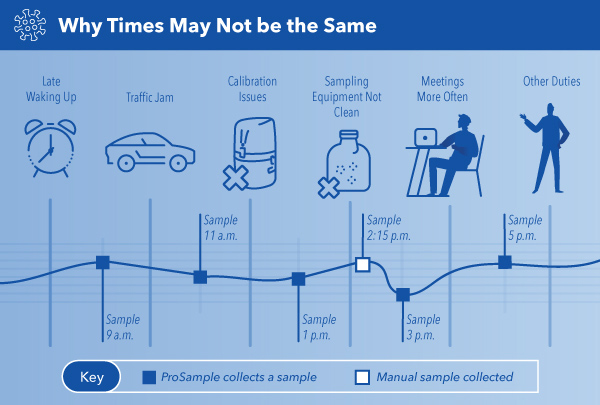
In today’s busy world, there are a number of factors that can prevent a technician from taking manual grab samples at a consistent time each day.
An autosampler, like the ProSample, minimizes the risk of these extenuating circumstances surrounding sample collection. For example, maybe a residential building is more populated in the morning, so it is ideal for collecting water samples as residents are preparing for their day. Perhaps in another case, a wastewater treatment facility wants to collect samples from a city that will not arrive until a few hours after regular business hours.
The ProSample can be programmed to collect samples based on time or flow pacing, meaning that scientists who deploy it do not have to worry about being physically present to collect a sample at the perfect time. In time-paced sampling events, you can program the autosampler to collect samples at certain times or specific time intervals, such as one sample every six hours. In flow-paced sampling, you can trigger sample collection every time the water flow rates hit a certain threshold at the collection site. This is possible by connecting third-party sensors to the ProSample to measure flow or gage height converted to flow – such as the SonTek IQ, YSI Amazon bubbler, or YSI Nile radar. Flow-paced sampling does not occur at regular time intervals, making it hard to have someone on-site to collect these samples.
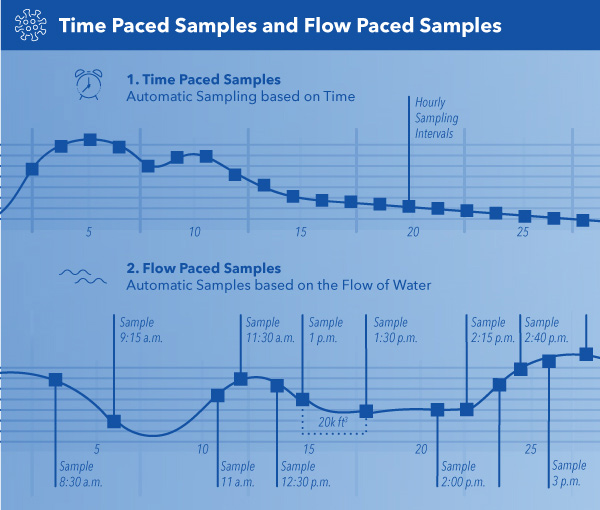
The ProSample can capture water samples at a specific time internal (e.g. every hour), or it can be connected to third-party sensors and collect samples based on water flow rates or gage height.
The ProSample will sample 24 hours a day, seven days a week; somebody just needs to pick up the samples!
Manual sampling is also a challenge because the sampling technique between technicians may not be the same, and sampling locations may differ. While we are all typically trained to follow similar sampling protocols within an organization, each individual tends to find one or two minor deviations from the standard protocol that "makes their job easier." These deviations could include collecting a sample from the water's edge instead of wading into the middle to collect a sample per protocol. While this situation is more reminiscent of stream sampling, similar issues happen when different technicians pull samples in pipes or treatment facilities.
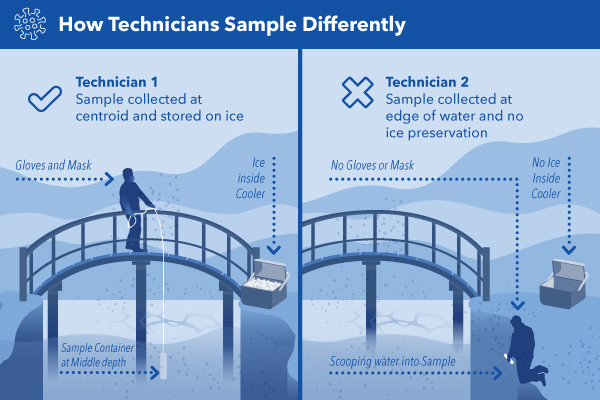
Not all technicians pull water sample in the same way. Even with standard operating procedures (SOPs) in place, it’s impossible to ensure samples are captured in a consistent manner without using an autosampler like the ProSample.
Is the sample collected at the proper depth? Was the right portion of the system sampled to maintain consistency? Was the sample in a well-mixed location, or was the sample poorly mixed and not representative?
Adding an autosampler unit, such as the ProSample, to a system ensures that the depth and horizontal location of the collected samples are the same every time that a sample is collected. This consistency in sample location eliminates some of the errors associated with sampling by removing location bias. It is critical to pick the right place to install an autosampler, however. Evaluate potential locations (such as shallow filled pipe versus full pipe) to ensure that the sampler will collect representative samples no matter what the channel or process conditions are.
Finally, different studies will require separate bottles of sample water for analysis, while others may prefer to composite the collected samples into a single, large container. There is no right or wrong reason for choosing either of these options, and the ProSample has a wide variety of bottle choices to use as well. Researchers typically want HDPE containers for sample collection, and the ProSample can be equipped with 1 to 24 of these different sized containers. The material used as pump tubing can also be changed from plastic tubing to a Teflon-lined tubing at the user's discretion. The tubing setup depends on if additional analyses are going to be performed on the samples besides SARS-CoV-2 tracking.
Once a sample is collected and properly preserved, many scientists can perform a PCR reaction in-house while others prefer to send the samples to an outside agency for analysis. Regardless of the samples' final destination, the YSI ProSample autosampler can certainly positively augment your current sampling program in many ways. It can provide a safe environment for employees, consistent samples based on time and location, and properly preserving specimens until they are picked up for processing.
If you have any questions about ProSample and how it could benefit your organization--or about sampling for COVID-19 in general, contact us at info@ysi.com, Ask a Question, use the Chat function, or on social media.

References:
- https://www.cdc.gov/coronavirus/2019-ncov/faq.html?CDC_AA_refVal=https%3A%2F%2Fwww.cdc.gov%2Fcoronavirus%2F2019-ncov%2Fphp%2Fwater.html#COVID-19-and-Water
- https://www.waterrf.org/system/files/resource/2020-03/Coronavirus_Webcast_031220_APPVDFINAL.v4.pdf
- https://www.waterrf.org/sites/default/files/file/2020-06/COVID-19_FieldSampleCollectionForm.pdf
- DOI:10.1016/S2666‐5247(20)30003‐3
- https://www.medrxiv.org/content/10.1101/2020.04.05.20051540v1.full.pdf
Additional Blog Posts of Interest
Solving Water During a Pandemic: What Could Be More Essential?
Coronavirus Disinfectants and the Need for More Production
How to Disinfect Your Water Quality Equipment